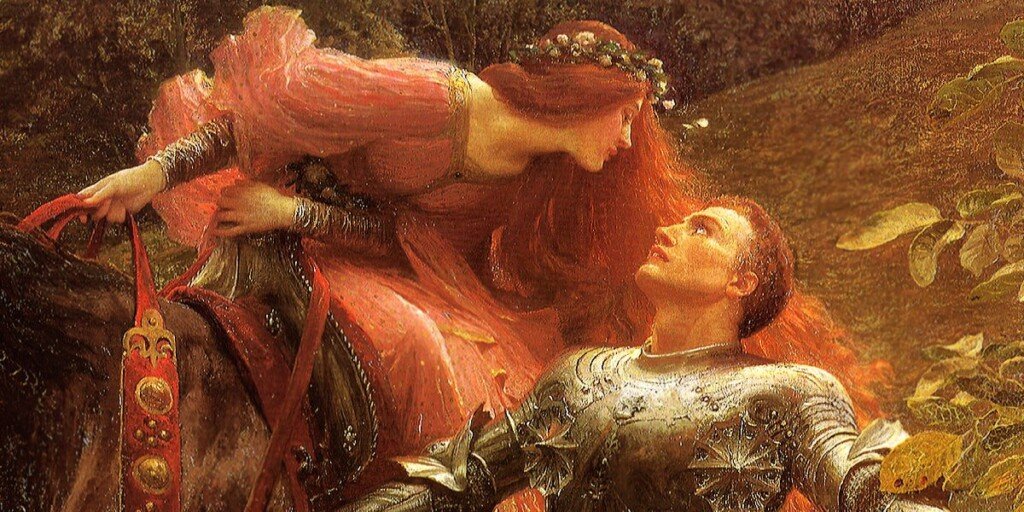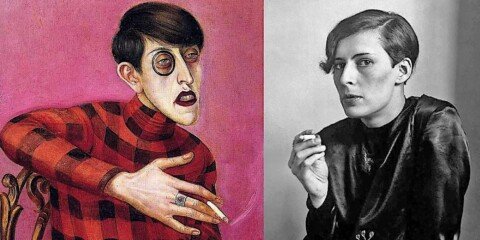An Introduction: A Painting that Listens to the Soul
Some works are to be seen, but others ask to be felt. It falls firmly into the second category. La Belle Dame sans Merci by Sir Francis Bernard Dicksee was painted in 1901. The haunting poem by John Keats of the same name inspired this painting. It is more than just a visual translation of a literary piece. It creates an affective emotional journey into themes of love, enchantment, betrayal, and the fragility of the human spirit.
This personal commentary shall closely read the painting analysis. It examines not just what it’s seeing. It delves into what it’s really feeling. It is for those interested in more than the history of the art. It is for those who wonder why this work continues to create magical enchantment. This persists more than a hundred years later.

Meeting the Artist: Sir Francis Bernard Dicksee
Sir Francis Bernard Dicksee was not only a painter; he was a storyteller with a brush. Born in 1853 into an artistic family in Fitzroy Square, Bloomsbury, Dicksee early learned the art. His father Thomas Dicksee trained him. He also trained alongside his sister Margaret. He became the talk of the town soon after being a student at the Royal Academy in 1870.

Frank Dicksee drew from literature, myth, and medieval legend. He produced huge dramatic emotional scenes. This marked him as a leading Victorian artist. His style employed rich color and emotional nuance with fine detail to powerful effect. By 1924 he had become the president of the Royal Academy. He received his knighthood in 1925. By 1927, he was named into the Royal Victorian Order. A most poignant and unforgettable of his works is La Belle Dame sans Merci-a canvas where every stroke can speak.
The Poetic Source: Keats’ Vision of Love and Loss
This painting by Dicksee derives its very soul from Keats’ poem, La Belle Dame sans Merci. The poem is from 1819. It echoes a medieval French ballad. The poem tells of a knight who becomes entranced by a mysterious woman out in the meadows. She enchants him and leads him into a waking dream of desire. Then she abandons him alone and forlorn on a “cold hill’s side.”
Keats’ work stands as an example of English Romanticism; full of symbolism, yearning, and melancholy. His knight, completely drained of life, serves as a caution against the perils of idealized love and blind infatuation. In the language of painting, Dicksee captures this poetic essence in a single cinematic moment of the knight’s emotional unraveling.
Sectional Analysis: A Reading of the Painting
Central Figures: A Portrait of Bewilderment and Despair
In the center of the painting, the woman sits gracefully on the horse. The gown she wears flows gracefully in shades of pink, glowing with borrowed light against the green countryside. Her red hair whips in wildness behind her, crowned with a garland of wildflowers that the knight has gifted her. She is a muse and a deep mystery.
The knight walks beside her, clad in armor, weak in spirit. The extended arms and vacant look show a bewitched soul. It is enthralled not only by beauty but the illusion of it. He once was an image of honor and resolve, now a shadow of himself.

The Hidden Detail: Who Holds the Reins?
A critical but easily missed detail: the knight is leading the horse. Nevertheless, the reins are firmly held in the woman’s hands. This subtle inversion of control changes the meaning of the whole scene. She is no longer a passive player carried by circumstances; she is in command. Her grip on the reins is more than simply physical; it symbolizes her emotional dominance.

Nature as Symbol: Beauty with a Hint of Rot
The English countryside is captured in picturesquely living shades of green and gold. But look again: a branch brushing the knight’s arm bears wrinkled leaves, a mere inconspicuous yet disquieting herald. Just as autumn foretells winter, this dead foliage foreshadows the knight’s doom. It is nature’s whisper that not all is well in this seeming pastoral paradise.

The Femme Fatale: Beauty as Doom
The woman is more than a beautiful figure: she is the quintessential femme fatale. Like legendary enchantresses like Circe or the Sirens, she weaponizes beauty, charm, and seduction. Her gaze demands not affection but submission. There is nothing to read upon her face, no remorse for her actions. She is equally alluring and lethal.

The Knight’s Fall: From Strength to Submission
His armor was once a token of protection. Now, it carries him down. His sword has become a mere scrap of metal. He has bartered courage for frailty. He traded freedom for obsession. His frame is stiff and outstretched. It is sunder in its hollow pose. This marks the death of love and the birth of a loss of self.

Emotional Resonance: Why It Hurts So Much
Standing in front of an artwork, the viewer can almost feel the knight’s agony. Have we not all, at one moment or another, pursued beauty to our damnation? Dicksee does not paint a fairytale. Instead, he invokes an oft-familiar ache. This ache is the attainment of something just tantalizingly beyond reach. It is also the melancholy that follows the faded illusion.
This notion of vulnerability is not one of melodrama. It is a depiction of humanity. The knight does not cry out. His silence shouts louder. The indifference of the woman, her almost tranquil stature, aggravates the wound. She is neither cruel in the ordinary sense nor benign. She is a natural phenomenon, neither good nor evil, but simply a reality.
Why the Painting Continues to Matter
La Belle Dame sans Merci endures, not because of its beauty (its beauty is indisputable), but because of its truth. It posits universal human experiences: hope in love, the risk of want, and grief after awakening. It’s the painting that mirrors a somewhat universal experience. It depicts the yearning for the image of an ideal. People are consumed by this yearning.

For the contemporary audience, it also works as a window into Victorian art’s fascination with medievalism and romantic escapism. During a period of industrial expansion, artists like Dicksee sought to understand current issues. They did so through meaningful allegories of the past.
The Enduring Spell of La Belle Dame sans Merci
Sir Francis Bernard Dicksee’s La Belle Dame sans Merci is more than just a painting. It is a tale and a warning. The artwork is also a tribute to artistic excellence. Every detail is evocative: Brilliant colors paired with subtle symbolism invite our meditations upon the complexities of human nature. Whether lured by its eerie beauty, tangled symbolism, or ageless themes, there is something for all in this masterpiece.
Next time you chance upon this painting, take the time to look at it. The decayed leaves stand out against the knight’s arm. The woman holds the reins firmly. The knight’s blank stare tells a tale of love, loss, and the fragility of dreams. Let it carry you into a world where beauty and danger kiss.
Thank you for this little excursion into the heart of La Belle Dame sans Merci. I hope you have enjoyed delving into its depths as much as I have. There is so much more to this painting than mere admiration; it is a tale that speaks to the heart. Keep hunting for other wondrous works and allow art to enhance your life.
Check Out Our Earlier Art Article
If you enjoyed this exploration, be sure to check out my earlier commentary. It’s titled A Personal Commentary on Portrait of the Journalist Sylvia von Harden.

A Personal Commentary on Portrait of the Journalist Sylvia von Harden
Explore Otto Dix’s iconic “portrait of the journalist Sylvia von Harden”. Delve into the cultural critique behind this unforgettable piece. Otto Dix’s signature painting “Portrait of the Journalist Sylvia von Harden” stands out audaciously. It is one of the most striking presentations of the “New Woman” in the 1920s. This iconic piece challenges traditional norms. Delve into all the symbolism, legacy, and ever-relevant resonance of this unforgettable work.
Let us carry on finding out how art reveals who we are, what we crave, and what we dread.
Thank you for reading. I hope your next experience with a work of art leaves you every bit as charmed. It also leaves you every bit as reflective.
Written by Discoverer of ART
Editor, curator, publisher
Twitter (X) – @DesignResource_





